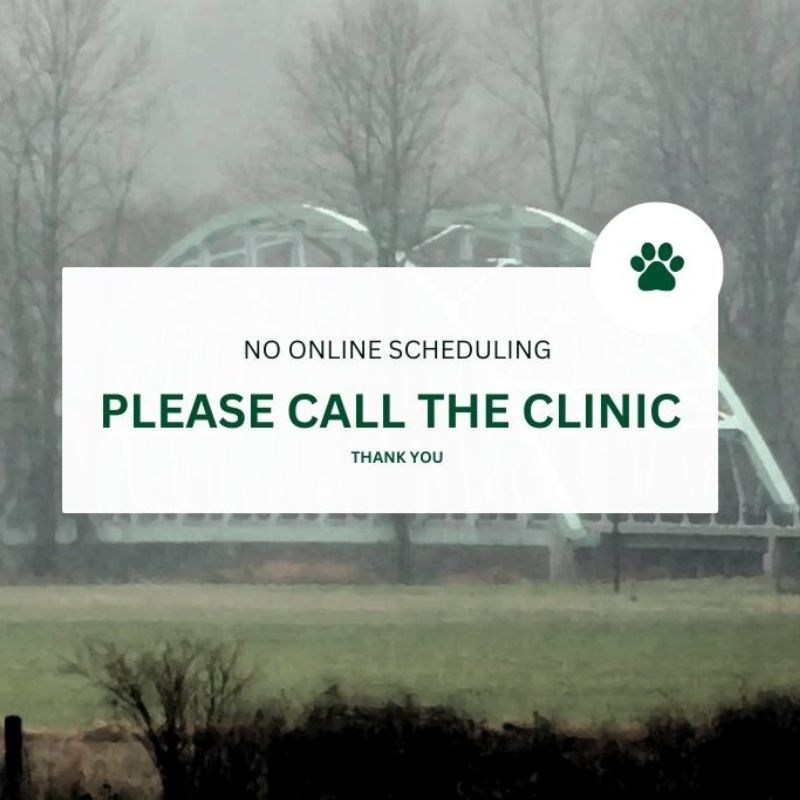Conditions
All pets with an emergency listed below should be seen by a veterinarian immediately.
Pet Emergency Conditions
The following emergencies can be quickly life-threatening and necessitate an immediate response.
Allergic Reactions
Signs:
- Swelling and/or redness around the lips and/or eyes
- Swelling around the face and/or neck
- Pale gums
- Difficulty breathing
- Vomiting
- Staggering, weakness, collapse, severe itching, hives
Common causes:
- Insect bites
- Vaccines
- Drugs (i.e., antibiotics, accidental ingestion of human medications)
First aid:
- Call or take your pet to the veterinarian or after-hours emergency clinic.
Bleeding
Signs:
- Arterial blood is generally bright red and squirts with the pulse
- Venous blood is generally purple/red and oozes
- Coffee ground appearance in vomitus, or bright red blood in vomitus
- Black tarry stool or frank blood in the stool
Common causes:
- Trauma
- Rodenticide toxicity
- Other anticoagulants, including Aspirin
First aid:
- Apply pressure to the area that is bleeding, taking care to not get bit by the animal
- Don’t remove bandages that are soaked through; apply new bandages on top
Bloat
Signs:
- Excessive drooling, often thick and ropy saliva
- Unproductive vomiting and retching
- A dog may produce frothy, foamy material in small quantities
- Agitated, uncomfortable, won’t lie down, pacing
- Anorexia
- +/- Abdominal swelling or bloated appearance
Common causes:
- Deep-chested breeds are more affected
- Hypothesized that may be due to rapid food and/or water intake, exercise
First aid:
- There are no home treatments for bloat, and the pet should be seen by a veterinarian immediately.
Blocked Cat
Signs:
- Frequent trips to the litter box
- Straining to urinate and not producing urine or producing very small amounts
- Blood in the urine
- Vocalizing while in the litter box
- Lethargy, anorexia, not wanting to move
- Painful abdomen (cries or hisses when a cat is picked up or the abdomen is touched)
- Attempting to urinate in odd places (i.e., bathroom tub, sink, floor, etc.)
- +/- Vomiting
Common causes:
- More frequently seen in overweight neutered males
- More frequently seen in cats with a history of urinary crystals (may not have been diagnosed prior to blocked episode)
First aid:
- There are no home treatments for urinary blockage, and the cat should be seen by a veterinarian immediately.
Breathing Problems
Signs:
- Abdominal effort with each breath
- Open-mouth breathing in cats
- Cyanotic, or blue, gum color
- Panting in dogs that do not subside with rest
- Marked respiratory noise (may indicate an obstruction)
Common causes:
- Allergic reactions
- Upper airway obstructions
- Asthma (more common in cats)
- Primary lung disease (infection, cancer, other)
First aid:
- Varies depending on the cause of the breathing problem.
- Generally speaking, there are no home treatments for respiratory distress, and the pet should be seen by a veterinarian immediately.
Burns
Signs:
- Moist red skin with no hair
- History of being in the vicinity of a hot object or fire
Common causes:
- Trauma
First aid:
- Apply a cool, wet washcloth (if the pet will allow), especially if oozing or seeping
- Transport quickly to a veterinarian
Compound Fractures
Signs:
- Fractured bones that protrude through the skin
- May or may not be associated with a large amount of bleeding
Common causes:
- Trauma
First aid:
- Move the fractured area as little as possible
- Transport quickly to a veterinarian
- May need a stretcher for larger dogs
Deep Lacerations
Signs:
- Lacerations that have excessive bleeding
- Lacerations that have areas of muscle and/or bone exposed
Common causes:
- Trauma
First aid:
- Cover the wound to control bleeding with gentle pressure
- See bleeding
- Transport the pet quickly to a veterinarian
Dystocia (Difficulty With Labor)
Signs:
- Not progressing into the second stage of labor (delivery of puppies or kittens) after 6-8 hours of the first stage of labor
- Foul-smelling discharge with no puppies or kittens delivered or knowing that more should be delivered but are not
- Heavy, persistent flow of blood prior to, during, or after delivery
- Mother exhibiting muscle weakness, muscle spasms, tremors, muscle rigidity, or seizures
- Straining for more than 20 minutes without the production of a kitten or puppy
- Weak, intermittent contractions for 1 hour without the production of a kitten or puppy
- Passed fetal membranes but no puppies or kittens
- More than 1 hour has passed between the birth of puppies or kittens
- Intense abdominal pain and/or shock
Common causes:
- Seen more in brachycephalic breeds such as Pugs, English Bulldogs, and Shih Tzu’s.
- Large puppies or kittens occur more commonly in small litters
First aid:
- To resolve dystocia, a cesarean section may be necessary and best for the puppies or kittens.
- Call or take your pet to the veterinarian or after-hours emergency clinic for advice.
Eye Trauma
Signs:
- Blinking frequently
- Squinting
- Conjunctivitis (pink swelling around the eye).
- Ocular discharge
- The eye appears larger or smaller than the opposite side
Common causes:
- Trauma
- Brachycephalic breeds such as Pugs, Boston Terriers, and Lhasa Apsos are more prone to having eye problems
- Age-related change
- Infectious
First aid:
- Do not handle the eye; prevent the pet from scratching at the eye
- Transport the pet quickly to the veterinarian
Gun Shot Wound
Signs:
- Entry +/- exit wound
- Wounds are round, +/- hemorrhage
- May fracture bones, damage internal organs
Common causes:
- Dog or cat has strayed onto the neighbor’s property
First aid:
- Control bleeding if present
- Transport the pet quickly to a veterinarian
Heat Stroke
Signs:
- Excessive panting (dogs), open mouth breathing (cats)
- Bright red mucous membranes
- Weakness
- Collapse
- Hot to the touch (unreliable indicator)
Common causes:
- Pets at greatest risk of heat stroke include…
- Young (< 6 months) or old (> 7 years)
- Overweight
- Brachycephalic
- Present or recent illness
- Large breeds
- Pets taking sedatives and anti-histamines
- Windows up in the car while it is warm outside (doesn’t have to be overly hot)
- Locked in a small room with poor ventilation
- Heavy exercise
First aid:
- Move the pet to a cool area
- Rinse cool water over the paws, may use alcohol as well
- Transport the pet quickly to a veterinarian
Hit By Car
Signs:
- If the event is not visualized…
- Difficulty breathing
- Road rash
- Limping
Common causes:
- The pet has strayed out of the yard and onto a road
- Pet is sleeping or lying in the driveway
First aid:
- Transport the pet quickly to a veterinarian. It may be to wrap a large blanket around your pet for transport.
Poisoning/toxin Ingestion
Signs:
- Dependent upon the toxin ingested (see the page on Toxins)
- Muscle weakness, muscle tremors
- Seizures
- Petechia (red spots) of the gums
- Vomiting, diarrhea, GI upset
- Urinary problems
Common causes:
- Toxins in the garage or household that are not stored out of pets’ reach
- Accidental ingestion of human medications
First aid:
- May recommend to induce vomiting depending on what was ingested
- Activated charcoal is indicated in some cases
- May call poison control (see the page on Toxins)
- Transport quickly to a veterinarian
Seizure
Signs:
- Uncontrolled body movements
- Frequently lose urinary and bowel control during the seizure
- Disoriented afterward
- Is considered an emergency (seek immediate care) when…
- Seizures last longer than 1 minute
- Seizures cluster – reoccurring episodes
- Pet does not recover from the seizure
- More than 1 seizure per week
Common causes:
- Many seizures are idiopathic (have an unknown cause)
- Toxins
- Brain tumors
- Infectious (bacterial meningitis, viral meningitis, etc)
First aid:
- If your pet has been prescribed diazepam for seizures, it may be administered rectally.
- Move objects and people away from the pet to prevent injuries
- If first time occurrence, transport the pet immediately to a veterinarian
- If the pet has a history of seizures, may increase or alter anti-seizure medication. Discuss with the veterinarian.

